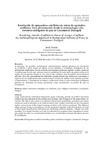Identificador persistente para citar o vincular este elemento:
https://accedacris.ulpgc.es/handle/10553/12819
| DC Field | Value | Language |
|---|---|---|
| dc.contributor.author | Tomás, Jordi | en_US |
| dc.date.accessioned | 2015-02-14T03:30:41Z | - |
| dc.date.accessioned | 2018-03-15T14:28:56Z | - |
| dc.date.available | 2015-02-14T03:30:41Z | - |
| dc.date.available | 2018-03-15T14:28:56Z | - |
| dc.date.issued | 2014 | en_US |
| dc.identifier.issn | 1133-598X | en_US |
| dc.identifier.uri | https://accedacris.ulpgc.es/handle/10553/12819 | - |
| dc.description.abstract | A menudo, las grandes instituciones internacionales aplican políticas de resolución de conflictos a gran escala sin fijarse en los sistemas y estrategias endógenos de las poblaciones implicadas. En este artículo intentaremos presentar algunos valores, prácticas e instituciones locales que intentan resolver conflictos de todo tipo a pequeña escala en la región de Casamance, donde se vive uno de los conflictos más duraderos del continente africano. Para ello, presentamos los diferentes grupos étnicos que habitan en Casamance y algunas de sus instituciones más características a la hora de mediar entre familias, pueblos o comunidades. Y finalmente invitamos a reflexionar sobre si estas estrategias endógenas podrían ser utilizadas de forma coordinada como contribución al proceso de paz en Casamance. | en_US |
| dc.description.abstract | Large international institutions frequently apply sweeping policies of conflict resolution without paying attention to the endogenous systems and strategies of the populations involved. The aim of this article is to present several local institutions, practices and values which are used in attempts at all kinds of small-scale conflict resolution in the Casamance region, scene of one of the longst-running conflicts in the African continent. The different ethnic groups living in Casamance will be presented together with descriptions of some of their most characteristic institutions for mediating between families, villages and communities. It is hoped that this will lead to reflections on whether these endogenous strategies might be used in a coordinated fashion as a contribution towards the peace process in Casamance. | en_US |
| dc.format | es | |
| dc.language | spa | en_US |
| dc.relation.ispartof | Vegueta: Anuario de la Facultad de Geografía e Historia | en_US |
| dc.source | Vegueta [ISSN 1133-598X], n. 14, p. 155-184, (2014) | en_US |
| dc.subject | 630402 Solución de conflictos | en_US |
| dc.subject.other | Resolución endógena de conflictos | en_US |
| dc.subject.other | Paz | en_US |
| dc.subject.other | Religión tradicional | en_US |
| dc.subject.other | Casamance | en_US |
| dc.subject.other | Senegal | en_US |
| dc.subject.other | Endogenous conflict resolution | en_US |
| dc.subject.other | Peace | en_US |
| dc.subject.other | Traditional religion | en_US |
| dc.title | Resolución de "pequeños" conflictos en zonas de "grandes" conflictos. Una aproximación desde la antropología a las nociones endógenas de paz en Casamance (Senegal) | en_US |
| dc.title.alternative | Resolving «Small» Conflicts in Zones of «Large» Conflicts: An Anthropological Approach to Endogenous Notions of Peace in Casamance (Senegal) | en_US |
| dc.type | info:eu-repo/semantics/article | en_US |
| dc.type | Article | en_US |
| dc.compliance.driver | 1 | es |
| dc.identifier.absysnet | 234500 | - |
| dc.description.lastpage | 184 | en_US |
| dc.identifier.issue | 14 | - |
| dc.description.firstpage | 155 | en_US |
| dc.investigacion | Artes y Humanidades | en_US |
| dc.rights.accessrights | info:eu-repo/semantics/openAccess | es |
| dc.type2 | Artículo | en_US |
| dc.description.numberofpages | 30 | en_US |
| dc.utils.revision | Sí | en_US |
| dc.identifier.ulpgc | Sí | en_US |
| dc.description.esci | ESCI | |
| dc.description.dialnetimpact | 0,0 | |
| dc.description.dialnetq | Q4 | |
| dc.description.erihplus | ERIH PLUS | |
| item.fulltext | Con texto completo | - |
| item.grantfulltext | open | - |
| Appears in Collections: | Artículos Vegueta. n.14, 2014 | |
Page view(s)
52
checked on Oct 28, 2023
Download(s)
153
checked on Oct 28, 2023
Google ScholarTM
Check
Share
Export metadata
Items in accedaCRIS are protected by copyright, with all rights reserved, unless otherwise indicated.
